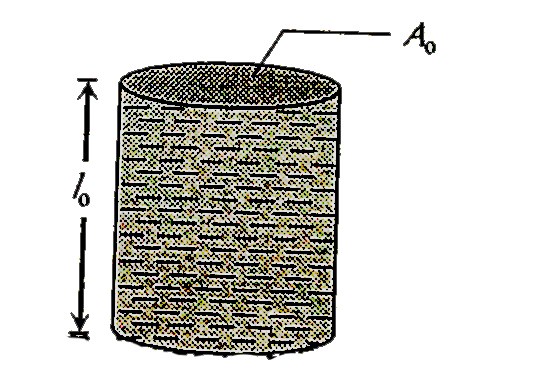The liquid with co-efficient of volume expansion is filled in a container of a material having the co-efficient of linear expansion . If the liquid overflows on heating then Solution in Bengali
The correct Answer is:B
Apparent coefficient of volume expansion,
Now, is positive when the liquid overflows on heating.
So the condition is
The option (B) is correct.
Topper's Solved these Questions
- BOOK - CHHAYA PUBLICATIONCHAPTER - EXPANSION OF SOLIDS AND LIQUIDSEXERCISE - EXAMINATION ARCHIVE - WBJEE2videos
EXPANSION OF SOLIDS AND LIQUIDS
- BOOK - CHHAYA PUBLICATIONCHAPTER - EXPANSION OF SOLIDS AND LIQUIDSEXERCISE - EXAMINATION ARCHIVE - JEE MAIN3videos
EXPANSION OF SOLIDS AND LIQUIDS
- BOOK - CHHAYA PUBLICATIONCHAPTER - EXPANSION OF SOLIDS AND LIQUIDSEXERCISE - ENTRANCE CORNER - INTEGER TYPE4videos
EXPANSION OF SOLIDS AND LIQUIDS
- BOOK - CHHAYA PUBLICATIONCHAPTER - EXPANSION OF GASESEXERCISE - CBSE Scanner1videos
EXPANSION OF GASES
- BOOK - CHHAYA PUBLICATIONCHAPTER - FIRST AND SECOND LAW OF THERMODYNAMICSEXERCISE - CBSE SCANNER18videos
FIRST AND SECOND LAW OF THERMODYNAMICS
Similar Questions
A metal rod is fixed rigidly at two ends so as to prevent its thermal expansion. If L, α and Y respectively denote the length of the rod, coefficient of linear thermal expansion and Young's modulus of its material, then for an increase in temperature of the rod by ΔT, the longitudinal stress developed in the rod is
02:05View SolutionThe pressure that has to be applied to the ends of a steel wire of length 10 cm to keep its length constant when its temperature is raised by 100∘C is (For steel, Young's modulus is 2×1011N⋅m−2 and coefficient of linear expansion is 1.1×10−5K−1)
02:45View SolutionA composite rod is made by joining a copper rod, end to end, with a second rod of a different material but of same cross-section. At 25∘C, the composite rod is 1 m in length of which the length of the copper rod is 30 cm. At 125∘C the length of the composite rod increases by 1.91 mm. The coefficient of linear expansion of copper is α=1.7×10−5∘C−1 and that of the second rod is β=n×10−5∘C−1. Find the value of n.
06:02View SolutionExplain why air pressure in a car tyre increases during driving.
03:22View SolutionWrite the second law of thermodynamics.
04:03View SolutionOn heating a liquid of coefficient of cubical expansion gamma in a container having coefficient of linear expansion gamma//3 . The level of liquid in the container will
02:08View SolutionA liquid with coefficient of volume expansion gamma is filled in a container of a material having coefficient of linear expansion alpha . If the liquid overflows on heating, then
02:22View SolutionThe figure shows a glass tube (linear co-efficient of expansion is α) completely filled with a liquid of volume expansion co-efficient γ . On heating length of the liquid column does not change. Choose the correct relation between γ and α
 03:52View Solution
03:52View SolutionIf a liquid having coefficient of volume expansion alpha , kept in a container having coefficient of linear expansion alpha/3 , is heated, then the level of the liquid will
01:18View SolutionThe coefficients of real expansion of a liquid is γ and the coefficient of linear expansion of the material of the containing vessel is α. Then the condition for no apparent expansion of the liquid in that vessel is
04:26View SolutionA liquid with coefficient of volume expansion γ is filled in a container of a material having the coefficient of linear expansion α. If the liquid overflows on heating
01:03View SolutionA liquid with coefficient of volume expansion gamma is filled in a container of a material having the coefficient of linear expansion alpha . lf the liquid overflows on heating
05:35View SolutionA liquid having co-off of cubical expansion γ is filled in the container having coefficient of linear expansion α. If on heating the liquid overflows, then which of the following relations is correct ?
01:36View SolutionThe co-efficient of volume expansion of a solid is 0.000054 /^@C . What is the linear expansion co-efficient ?
03:04View SolutionEstablish a relation between co-efficient of volume expansion and co-efficient of linear expansion.
10:10View Solution

